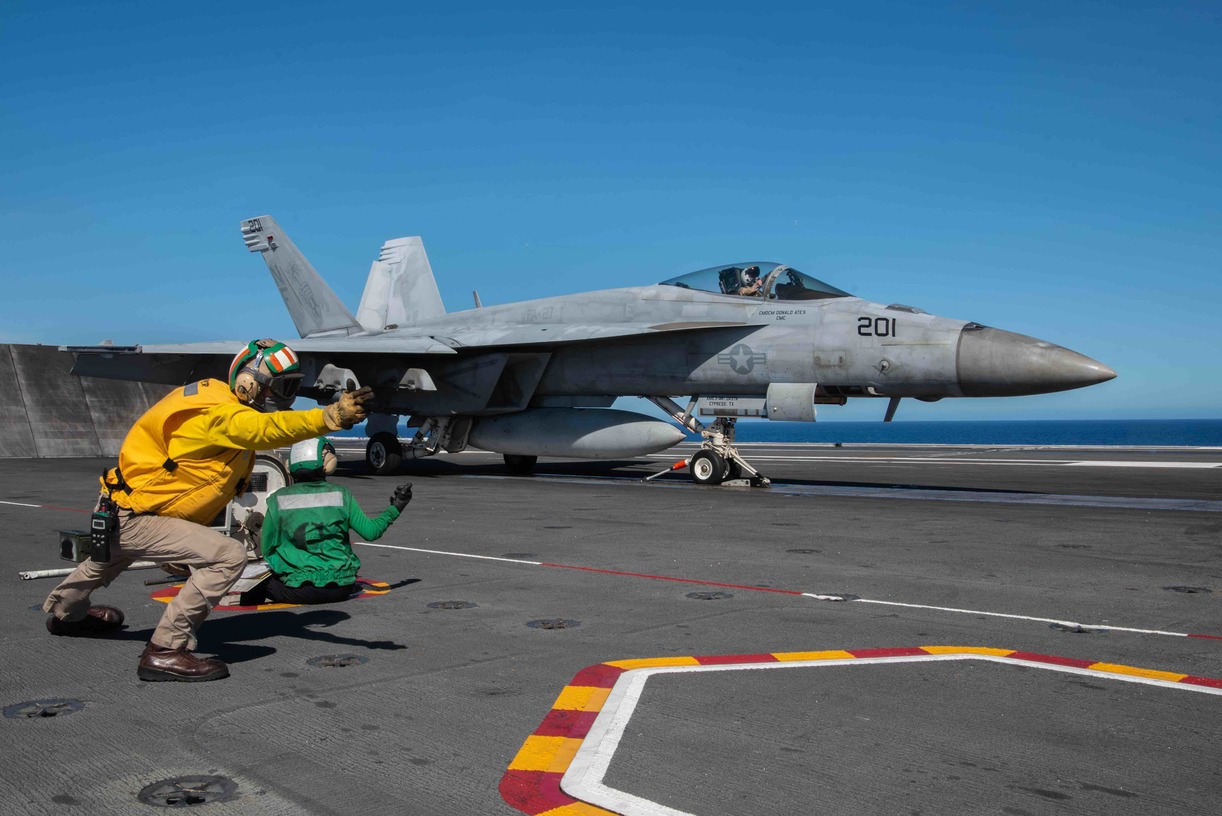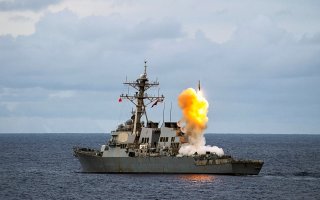5 Essential Books on Maritime Strategy You Need to Read
Admiral Lisa Franchetti, America’s chief of naval operations or top uniformed naval officer, recently released her first Navy Professional Reading List. The list is solid on the whole. There are, however, many books one could look at. Here are a few ideas.
Admiral Lisa Franchetti, America’s chief of naval operations or top uniformed naval officer, recently released her first Navy Professional Reading List. The list is solid on the whole. The books listed fall into three bins. Start with “Foundations,” a category concerned mainly with the industrial and engineering prerequisites for sea power. Works by Paul Kennedy and Arthur Herman lay the substructure for comprehending sea power and maritime strategy.
Next move on to “Warfighters,” selections that illuminate how U.S. Navy mariners can build cohesive teams, develop doctrine so they act in unison while doing business in great waters, and seek out ways to innovate. Among my favorite works of the past decade in any genre, and included in this category, is Daniel James Brown’s Boys in the Boat. I defy you to find a better guide to how to construct a team fit to pursue a common purpose and prevail.
Last comes “Warfighting,” whose works review how to bring combat power to bear in embattled marine theaters such as the Western Pacific. Works such as retired admiral Michael McDevitt’s profile of China’s navy cover contemporary opponents’ strategies and force structures. Strategies and operations of the past on such battlegrounds as Leyte Gulf and the Korean Peninsula also feature prominently.
There is much goodness here.
Yet CNO Franchetti’s list feels strangely partial compared to past lists. The works listed have much to say about the mechanics of executing strategy. They dwell on the how’s of strategy, operations, and tactics, which is doubtless crucial, but they say little about the why’s. That’s an important deficit. Naval folk need to know why they do what they do on a daily basis—not just how to carry out routine tasks—to truly flourish in the seaborne profession of arms.
Think about it. Strategy is the art and science of using power to fulfill purposes. That being the case, maritime strategy is the art and science of using sea power—defined, in rough terms, as a “chain” connecting domestic industrial production with merchant and naval fleets plying the main with access to foreign seaports—to fulfill purposes relating to the saltwater realm. In other words, it’s up to executors of strategy to devise ways to put the diplomatic, economic, and military means on hand—or additional means that can be marshaled by tapping national resources—to work achieving goals formulated by political leaders in concert with the larger society.
That larger dimension is missing here. The reading list is largely vacant of three pivotal things. First, there’s the theory underlying maritime strategy, operations, and fleet tactics. Theory is important. As a wise economist once noted, without a theory facts are silent. Including facts about how a society and its senior leadership make and implement foreign policy and strategy. Naval operations, in turn, are expressions of ideas about the nautical world and how to manage it. In other words, what navies do proceeds from a theory of cause and effect: if the fleet and its joint partners do X, the desirable result will be Y. It’s an oversight to exclude theory—ideas—from fighting sailors’ intellectual world. Let’s include them in the seagoing profession in all its richness.

Along the same lines, second, few entries on the list contemplate the larger purposes impelling maritime strategy. Soldier and military sage Carl von Clausewitz compiles the classic explanation of the relationship between purpose and power, observing that war—and, I would argue, warlike competition short of arms—has its own “grammar” but not its own “logic.” The grammar of international competition sees contestants grapple ceaselessly for strategic advantage. They deploy force, or mount a forbidding threat of superior force, in a bid to impose their will on an unwilling foe or rally allies and partners to their cause. The logic of strategy, though, derives from national policy. From purpose, in other words. Policy’s sway—and supremacy—does not stop when the shooting starts. Clausewitz proclaims that warfare is “just another expression” of the combatants’ thoughts, “another form of speech or writing.” Communicating those thoughts to rank-and-file seafarers helps them grasp what policymakers expect from the force—and makes them doughtier bearers of the nation’s strategic and operational fortunes. Reading helps.
And third, competition short of war is largely invisible on the reading list. Judging from the list, little happens left of bang, i.e., before the outbreak of violent conflict. In reality, endeavors preceding the outbreak of hot war claim an enormous if not decisive share of what the sea service does in concert with affiliated joint and allied forces. Deterring or coercing antagonists while reassuring allies, partners, and friends that the United States will be there for them when the going gets tough involves mounting a show of military capability, displaying the political willpower to use that capability under certain well-defined circumstances, and making key audiences believers in American capability and resolve. Only if the sea service falls short in peacetime competition does it need to morph into a “warfighting navy,” to borrow an oft-used slogan from Admiral Franchetti.
Neglecting these critical functions courts peril. The U.S. Navy needs a fighting ethos no matter whether missiles or bullets are flying around. Purpose and power need to be encoded in the service’s institutional DNA.
In short, the CNO reading list expresses a narrowcast view of the nautical profession—a view that’s apt to leave fleet sailors obsessing over engineering, weaponeering, tactics, and administration. By contrast a force made up of fighting sailors who understand the purposes behind their daily efforts will fare better in peacetime and wartime competition alike. Herewith, after that roundabout introduction, a companion list from your humble scribe to illumine the why’s as well as the how’s of maritime strategy:
Nicholas John Spykman, The Geography of the Peace and America’s Strategy in World Politics.
Geography is the arena where martial competition and strife rage, so geopolitics is the natural starting point for strategic success. Writing during World War II, Spykman, arguably the greatest geopolitical thinker ever to grace this fallen world, prescribed a U.S. strategy meant to shape events in the Eurasian “rimlands” in America’s favor. He believed American prosperity and security depend on it. To shape events in the rimlands, though, U.S. and allied sea services must be able to rule “marginal seas” that grant access to littoral zones in Western Europe, East Asia, and today South Asia. Navies can accomplish little in the rimlands if they can’t get there. Spykman’s insights remain as fresh today as when he penned them.
J. C. Wylie, Military Strategy: A General Theory of Power Control.
A short, accessible work that belongs on every seafarer’s bookshelf. Admiral Wylie, a serving naval officer, beseeched navy people to express themselves in plainspoken English rather than obscure their meaning in clouds of jargon and acronyms. He contended that the soldier, the “man on the scene with a gun,” was the arbiter of who won and lost wars. The soldier toted superior firepower and controlled geographic space. Air and naval forces existed to support the man on the scene with a gun. Wylie also hit on the notion of “sequential” and “cumulative” operations, depicting the former as the norm and the latter as a difference-maker. Sequential operations proceed step-by-step toward some goal on the map or chart, while cumulative operations deploy many small-scale engagements in scattershot fashion. The latter were not decisive, he maintained, but they could grind down a foe in a close-run struggle. Naval warfare, it bears noting, is predominantly cumulative in nature. Seldom is it a war-winner in itself.
John B. Hattendorf, Mahan on Naval Strategy: Selections from the Writings of Rear Admiral Alfred Thayer Mahan.
Naval War College emeritus historian John Hattendorf marshals the most valuable, most accessible selections from Alfred Thayer Mahan’s daunting body of work. Mahan lays out the six “elements,” or determinants, of sea power, exploring both the geophysical and human factors that bestow on some nations the right stuff for seafaring while denying it to others. These macro-elements comprise the sinews of maritime strategy. Mahan also considers the composition of fleets, how to size a fleet or fleet detachment to prevail in combat, and the elements of naval strategy complete with a wealth of historical illustrations. It would be dynamite if all U.S. Navy mariners acquainted themselves with the full range of Mahan’s treatises. Short of that, Hattendorf serves up an excellent substitute.
Julian S. Corbett, Some Principles of Maritime Strategy.
If Mahan concentrates mainly on the logic of maritime strategy—after all, he was exhorting the United States to make itself into a seafaring state of note at a time when the republic might choose otherwise—his English contemporary Julian Corbett showed how an established seafaring state should use its navy to operational, strategic, and political effect. Corbett explicates the grammar of naval warfare for the most part, making his work an excellent companion to Mahan’s. Mahan supplies the logic, Corbett the grammar.

Like Wylie, Corbett insists that wars are settled on land, and he insists that the navy represents an enabler for army operations around the maritime periphery. He details how fleets are constituted, investigates the sequence whereby high-seas wars normally unspool, and, unlike Mahan, pays homage to defensive operations as a temporary expedient even for the stronger fleet. Indispensable.


